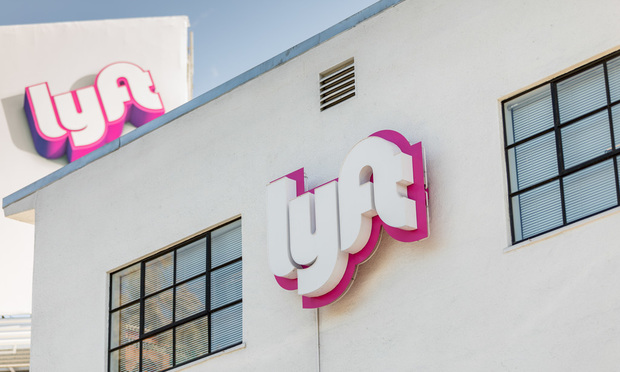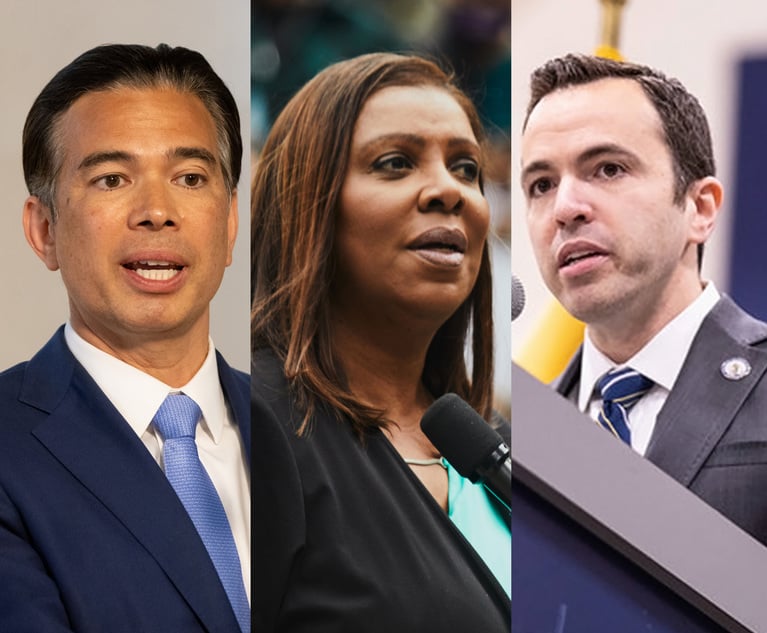NYC Passes Minimum Wage for Uber, Lyft Drivers, Will Others Follow?
The New York City Taxi and Limousine Commission (TLC) announced Tuesday that it had passed a series of rules that give for-hire drivers for companies such as Uber and Lyft a minimum wage of $17.22, which is expected to raise compensation for 80,000 drivers by as much as $10,000 annually. T
December 06, 2018 at 03:15 PM
4 minute read
The original version of this story was published on Corporate Counsel
 Lyft driver lounge called the Hub. Photo: Jason Doiy/The Recorder
Lyft driver lounge called the Hub. Photo: Jason Doiy/The Recorder
Labor and employment attorneys for companies and plaintiffs are uncertain as to whether the New York City's enactment of a minimum wage for Lyft and Uber drivers will spill over into other sectors of the gig economy or other cites and states.
The New York City Taxi and Limousine Commission (TLC) announced Tuesday that it had passed a series of rules that give for-hire drivers for companies such as Uber and Lyft a minimum wage of $17.22, which is expected to raise compensation for 80,000 drivers by as much as $10,000 annually. The passage of the new rule doesn't directly address the question of whether those working in the gig economy should be treated as full- or part-time employees with benefits, or just as contractors who can work or not work as they please.
“New York City is the first city globally to recognize that the tens of thousands of men and women who are responsible for providing increasingly popular rides that begin with the touch of a screen deserve to make a livable wage and protection against companies from unilaterally reducing it,” said TLC Chair Meera Joshi in the news release announcing the passage of the rules.
In separate statements, both Uber and Lyft indicated their support for drivers making a living wage, however, they said the rules will only create more problems.
“Lyft believes all drivers should earn a livable wage and we are committed to helping drivers reach their goals. Unfortunately, the TLC's proposed pay rules will undermine competition by allowing certain companies to pay drivers lower wages, and disincentives drivers from giving rides to and from areas outside Manhattan. These rules would be a step backward for New Yorkers, and we urge the TLC to reconsider them,” a spokesperson for Lyft said in a statement to Corporate Counsel.
Jason Post, Uber's director of public affairs, said in a statement that the rules will ultimately make fares higher for the consumer. “The TLC's implementation of the City Council's legislation to increase driver earnings will lead to higher than necessary fare increases for riders while missing an opportunity to deal with congestion in Manhattan's central business district,” Post said. He added, “Companies use incentives and bonuses as part of driver earnings to ensure reliability citywide by providing a monetary incentive to drivers to complete trips in areas that need them the most (such as outside of Manhattan).”
Gerald Hathaway, a partner at Drinker Biddle & Reath in New York, said he is not certain that the TLC had the authority to enact the rules.
“If you look at the City Charter there's an enumeration of powers that the Taxi and Limousine Commission shall have and Section 2303 of that charter lists what those things are. What I don't see is the authority to regulate compensation of drivers,” Hathaway said. “I'm sure that Uber and Lyft are looking at the pretty closely to see if there is a basis to challenge the code.”
Hathaway also said he is unsure if rules like this will become applicable for other types of work in the gig economy. “I think the gig economy is a number of things. It's new and it's disruptive to a lot of models. Existing laws are not easily applied because it is so new,” he said.
Rachel Bien, a partner at plaintiff firm Outten & Golden in Los Angeles, said that she is impressed that the rules were passed because of the fight that Lyft and Uber have put up in the past when faced with regulation.
“I think it's definitely a positive step in the right direction,” Bien said. “My own clients who work for these companies have seen pay increasingly depress as the companies compete with each other and lower rates.”
As far as similar rules being passed for other gig workers, Bien said she is not sure if this will open up discussion of creating a minimum wage for other gig-by-gig workers.“I don't know whether there is any potential for this being applied more broadly. I think it should,” she said.
Also Read: The Growing Gig Economy Brings New Worries For In-House Counsel Employers Face Open Questions After Landmark 'Dynamex' Labor Ruling
NYC Council Puts New Regulations on Ridesharing, With One-Year Vehicle Freeze
This content has been archived. It is available through our partners, LexisNexis® and Bloomberg Law.
To view this content, please continue to their sites.
Not a Lexis Subscriber?
Subscribe Now
Not a Bloomberg Law Subscriber?
Subscribe Now
NOT FOR REPRINT
© 2025 ALM Global, LLC, All Rights Reserved. Request academic re-use from www.copyright.com. All other uses, submit a request to [email protected]. For more information visit Asset & Logo Licensing.
You Might Like
View All

You’re Sure You’ve Looked? The Use of Jackson Affidavits and Efforts to Locate Discovery Materials


Federal Judge Pauses Trump Funding Freeze as Democratic AGs Plan Suit
4 minute readTrending Stories
- 1Robinson & Cole Adds to Immigration Team in Philly
- 2DC Circuit Revives Firefighters' Religious Freedom Litigation in Facial Hair Policy Row
- 3‘High Demand’: Former Trump Admin Lawyers Leverage Connections for Big Law Work, Jobs
- 4Considerations for Establishing or Denying a Texas Partnership to Invest in Real Estate
- 5In-House AI Adoption Stalls Despite Rising Business Pressures
Who Got The Work
J. Brugh Lower of Gibbons has entered an appearance for industrial equipment supplier Devco Corporation in a pending trademark infringement lawsuit. The suit, accusing the defendant of selling knock-off Graco products, was filed Dec. 18 in New Jersey District Court by Rivkin Radler on behalf of Graco Inc. and Graco Minnesota. The case, assigned to U.S. District Judge Zahid N. Quraishi, is 3:24-cv-11294, Graco Inc. et al v. Devco Corporation.
Who Got The Work
Rebecca Maller-Stein and Kent A. Yalowitz of Arnold & Porter Kaye Scholer have entered their appearances for Hanaco Venture Capital and its executives, Lior Prosor and David Frankel, in a pending securities lawsuit. The action, filed on Dec. 24 in New York Southern District Court by Zell, Aron & Co. on behalf of Goldeneye Advisors, accuses the defendants of negligently and fraudulently managing the plaintiff's $1 million investment. The case, assigned to U.S. District Judge Vernon S. Broderick, is 1:24-cv-09918, Goldeneye Advisors, LLC v. Hanaco Venture Capital, Ltd. et al.
Who Got The Work
Attorneys from A&O Shearman has stepped in as defense counsel for Toronto-Dominion Bank and other defendants in a pending securities class action. The suit, filed Dec. 11 in New York Southern District Court by Bleichmar Fonti & Auld, accuses the defendants of concealing the bank's 'pervasive' deficiencies in regards to its compliance with the Bank Secrecy Act and the quality of its anti-money laundering controls. The case, assigned to U.S. District Judge Arun Subramanian, is 1:24-cv-09445, Gonzalez v. The Toronto-Dominion Bank et al.
Who Got The Work
Crown Castle International, a Pennsylvania company providing shared communications infrastructure, has turned to Luke D. Wolf of Gordon Rees Scully Mansukhani to fend off a pending breach-of-contract lawsuit. The court action, filed Nov. 25 in Michigan Eastern District Court by Hooper Hathaway PC on behalf of The Town Residences LLC, accuses Crown Castle of failing to transfer approximately $30,000 in utility payments from T-Mobile in breach of a roof-top lease and assignment agreement. The case, assigned to U.S. District Judge Susan K. Declercq, is 2:24-cv-13131, The Town Residences LLC v. T-Mobile US, Inc. et al.
Who Got The Work
Wilfred P. Coronato and Daniel M. Schwartz of McCarter & English have stepped in as defense counsel to Electrolux Home Products Inc. in a pending product liability lawsuit. The court action, filed Nov. 26 in New York Eastern District Court by Poulos Lopiccolo PC and Nagel Rice LLP on behalf of David Stern, alleges that the defendant's refrigerators’ drawers and shelving repeatedly break and fall apart within months after purchase. The case, assigned to U.S. District Judge Joan M. Azrack, is 2:24-cv-08204, Stern v. Electrolux Home Products, Inc.
Featured Firms
Law Offices of Gary Martin Hays & Associates, P.C.
(470) 294-1674
Law Offices of Mark E. Salomone
(857) 444-6468
Smith & Hassler
(713) 739-1250






